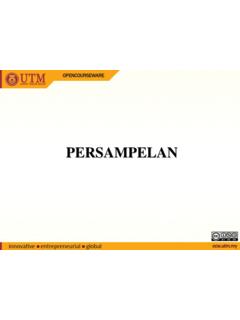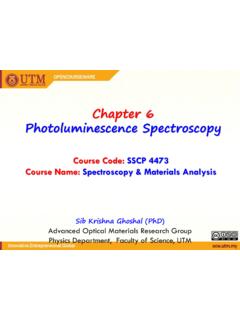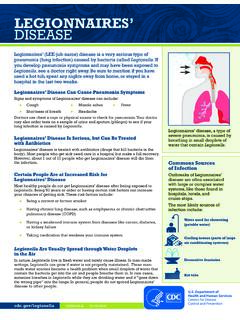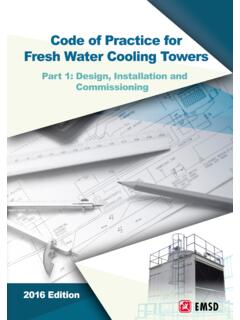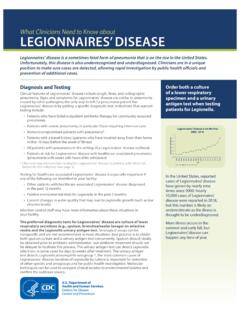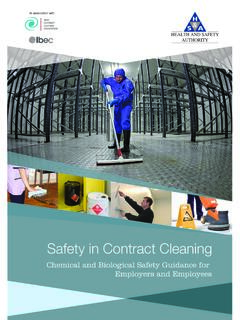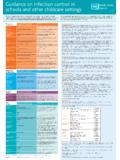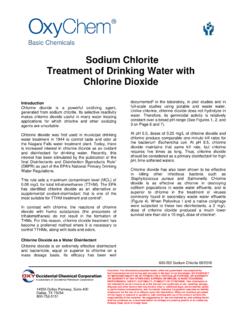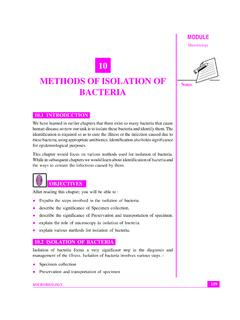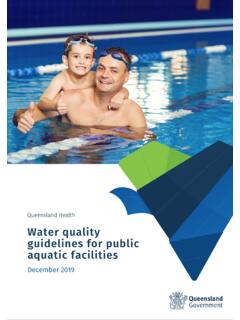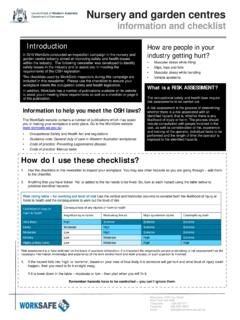Transcription of HAZARD IDENTIFICATION, RISK ASSESSMENT & RISK …
1 21/2/2013 1 Sr Dr. Mohd Saidin Misnan UNIVERSITI TEKNOLOGI MALAYSIA 81310 UTM Skudai, Johor, Malaysia HAZARD IDENTIFICATION, RISK ASSESSMENT & RISK control (HIRARC) 21/2/2013 2 OBJECTIVE The principles and practices of OSH HIRARC When to conduct HIRARC/Risk Assessments Why HIRARC is important How to identify HAZARD and evaluate risk To identify types of HAZARD in work area To suggest Risk Controls to Organization To implementing Risk Controls To review Risk Controls Section 1 : HIRARC Definitions & Concepts Section 2 : Process of HIRARC Section 3 : HAZARD Identification Section : HAZARD Identification Tools Section : Types of Hazards Section 4 : Risk ASSESSMENT Section : Analyzing Risk Section : Evaluation of Risk Section 5 : Risk control Approach Content 21/2/2013 3 OSH-MS (MS 1722:2003) Policy Organizing Planning And Implementation Measuring Performance Action for Improvement Key Elements Why We Need OSH-MS Our Organization to be No.
2 1 Increase Return of Investment - employees, money , Safe work place 21/2/2013 4 How To Start Organization should have vision Commitment from management - right people - resource - time Should have internal audit Management committee to review reports External audit Specific organization policy- HAZARD specific Employee s participation - meeting, training Safety as basic training How To Start 21/2/2013 5 Introduction to HIRARC Principles used in workplace to manage safety and health. Section 15 (2)(a) of OSHA 1994: which reads the provision and maintenance of plants and systems of work that are,so far as is practicable, safe and without risks to health Overview Of HIRARC Definition of Hazards Classification of Hazards Potential sources of Hazards Basic components of Risk Management 21/2/2013 6 To identify all the factors that may cause harm to employees and others (the hazards) To consider what the chances are of that harm actually befalling anyone in the circumstances of a particular case and the possible consequences that could come from it (the risks) To enable employers to plan, introduce and monitor preventive measures to ensure that the risks are adequately controlled at all times.
3 Purposes of HIRARC HIRARC Definitions and Concepts SECTION 1 21/2/2013 7 Source or situation with potential for harm in term of: i. Human injury ii. Ill health iii. Damage to property iv. Damage to workplace environment v. Or combination of these What is a HAZARD ? Combination of the likelihood and consequence(s) of a specified hazardous event occurring. What is a Risk? 21/2/2013 8 Likelihood that a HAZARD may occur (probability). Consequence(s) of the hazardous event (severity). Risk 2 Elements Definition HAZARD A source or a situation with a potential for harm to humans, property and damage of environment or a combination of these. Danger Relative exposure to HAZARD . Risk A combination of likelihood of occurrence and severity of injury or damage.
4 21/2/2013 9 Overall process of estimating the magnitude of risk and deciding whether or not the risk is tolerable. What is risk ASSESSMENT ? Measure taken to eliminate or mitigate the identified risks. Risk control 21/2/2013 10 Tolerable risk risk that has been reduced to a level that can be endured by the organization having regard to its legal obligations and its own OSH policy. Interested party individual or group concerned with or affected by the OSH performance of an organization. Other Definitions The Process of Risk Management Classify Activities (Work, Product, Services) Identify HAZARD Assess The Risk Risk control Review Risk control 21/2/2013 11 Risk Management Risk Management describes the total procedure associated with identifying a HAZARD , assessing the risk, putting in place control measures, and reviewing the outcomes.
5 Ongoing HIRARC activities HIRARC Covers: - Routine and non-routine activities - Activities of all personnel including non employees (contractors, visitors) - Facilities at the workplace Planning of HIRARC 21/2/2013 12 HIRARC LEGAL ACCIDENT & NEAR MISSES FEEDBACK & COMPLAIN INSPECTION& AUDIT SOP INTERNAL AUDIT POLICY SAFETY COMMITTEE TRANING ERP MANAGEMENT PROGRAM HIRARC -Planning & Implementation Process of HIRARC SECTION 2 21/2/2013 13 For situation: Where HAZARD appear to pose significant threat Uncertain whether existing controls are adequate Before implementing corrective or preventive measures By organization intending to continuously improve OSHMS. When to Conduct HIRARC 1. Identify HAZARD risk from each HAZARD Probability of occurrence Severity of harm 3.
6 Decide if risk is tolerable. HIRARC Process 3 Basic Steps 21/2/2013 14 Legal obligations (certain countries). To determine whether existing or planned controls are adequate. Risks should be controlled before harm could occur . Why is HIRARC Important? Classify work activities Consultation Identify Hazards Risk ASSESSMENT Prepare Risk control Action Plan (if necessary) Implement Employer Representative Worker Representative Review Criteria for HIRARC Process 21/2/2013 15 Possible ways. geographical or physical areas within/outside premises. Stages in production/service process Not too big. building a car Not too small. fixing a nut Defined task loading, packing, mixing, fixing the door Classify work activities Tasks carries out - duration & frequency - Site/location - Who involved/affected - Written system of work Plant/machinery used Tolls/equipment used MSDS/CSDS Services used - Compressed air, steam Type of material handled Distances/heights material to be moved Acts/Regulations/COP Reactive monitoring data Advice from specialist Work activities Information Requirement 21/2/2013 16 Determine risk Make a subjective ASSESSMENT of risk associated with each HAZARD assuming that planned or existing controls are in place.
7 Decide if risk is tolerable Judge whether planned or existing OSH precautions (if any) are sufficient to keep the HAZARD under control and meet legal requirements. Risk ASSESSMENT Prepare a plan to deal with any issues found by the ASSESSMENT to require attention. Organizations should ensure that new and existing controls remain in place and are effective. Prepare risk control action plan (if necessary) 21/2/2013 17 Execute the risk control plan. Monitor the effectiveness of the plan. Implement Re-assess risks on the basis of the revised controls. Check that risks will be tolerable. Review 21/2/2013 18 HAZARD IDENTIFICATION SECTION 3 HAZARD Identification To keep workplace safe and healthy. -employers should make sure there are no hazards to which employees could be exposed.
8 Employers should look for hazards in advance as part of their risk management plan to prevent potential hazards. 21/2/2013 19 Classify Work Activities Identify Hazards Identify all significant hazards relating to each work activity. Consider who might be harmed and how. Identify Hazards 21/2/2013 20 there a source of harm? could be harmed? harm could occur? Hazards Identification General (Qualitative) methods legislation and COP HAZARD checklist survey (audit), observation competency of personnel reactive data (previous incidents data) work process consultation with employees advice from specialist 10. OSH Journal / publications Identify Hazards 21/2/2013 21 HAZARD IDENTIFICATION TOOLS SECTION HAZARD and Operability Study (HAZOP) Failure Mode and Effects Analysis (FMEA) Job Safety Analysis (JSA) Fault Tree Analysis (FTA) Quantitative Methods 21/2/2013 22 To identify HAZARD in process and operability problems.
9 To study effects of deviation from process design condition. It takes a representation of a system and analyses how its operation may lead to an unsafe deviation from the intent of the system. HAZOP HAZOP 21/2/2013 23 HAZOP Guide Words None of .. More of .. Less of .. Part of .. As well as .. Reverse .. Other than .. FMEA is a systematic approach to; Recognize and evaluate the potential failure of a product/process and the effects of that failure. Identify actions that could eliminate or reduce the chance of potential failure occurring. Document the entire process. FMEA 21/2/2013 24 All FMEAs focus on the design, be it product or process: Design of FMEA (of product) Process FMEA (of process) Types of FMEA FMEA System Component Failure Mode Failure Effect Scrubber Water pump Inadequate water flow Increased environmental pollution 21/2/2013 25 Aerospace - Complex systems, processes and products Low volume manufacturer Automotive - Complex systems, processes and products High volume manufacturer Where are FMEA s currently used?
10 During the Advanced Product Quality Planning Process (APQP). Design FMEA applied during the product design and development. Process FMEA applied during process design and development. When are FMEA applied? 21/2/2013 26 Ideally, all jobs should be subjected to JSA. Usually useful for non routine activities. JSA Select job to be analyzed Define the scope of the job Organize the job into sequential logical steps Observe each job step to determine the hazards Develop preventive measure to eliminate the hazards JSA basic procedure 21/2/2013 27 JSA Shows the relation between system failure - a specific undesirable event in the system, and failures of the components of the system Technique based on deductive logic.

